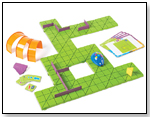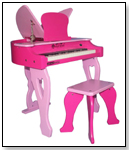|
|
Patents in the Toy and Game Industry: Part 2 Securing a Provisional and Using Patents to Grow
GAIN RIGHTS TO MAKE AND SELL 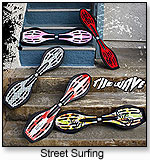 Patent rights confer a limited monopoly. They afford the patent holder the exclusive right to make, use, sell, or offer for sale any patented toy for a period of 20 years from the earliest filing date. Patent rights confer a limited monopoly. They afford the patent holder the exclusive right to make, use, sell, or offer for sale any patented toy for a period of 20 years from the earliest filing date.In concept licensing, the patent provides significantly stronger protection to the toy maker than does a standard non-disclosure agreement. Potential toy licensor L may require toy manufacturer M to maintain secrecy when reviewing a submitted concept. However, this non-disclosure will not protect the potential licensor L if a third-party toy maker P holds a patent right to a toy with a similar concept. Third-party patent holder P will have far greater negotiation ability than L because P will be able to guarantee exclusivity to toy manufacturer M, and the non-patented toy licensor L will not. The benefits of exclusivity are also important if a toy maker intends to self-produce a toy. The right of exclusivity offered by a patent will prevent other competitors from selling the same products for a period of time. When time, effort and finances are necessary to introduce a new toy to market, patents will help ward away trespassers and copycats. RIP UP THE COMPETITION 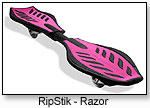 Korean sports leisure company Slovie licensed its “essboard” patent to manufacturers of both the Wave (Street Surfing) and the Ripstik (Razor). The latter has become a household name, while the former exists in relative obscurity. Korean sports leisure company Slovie licensed its “essboard” patent to manufacturers of both the Wave (Street Surfing) and the Ripstik (Razor). The latter has become a household name, while the former exists in relative obscurity.Although Slovie licensed both companies at the outset, as far as United States Patent and Trademark Office records show, it is significant that Slovie assigned its patent to Ripstik manufacturer Razor in November 2008. Control over the basic caster-board patent helped Razor’s sales on competing sports products that are similar in appearance and operation. In view of this, it is not surprising that Street Surfing’s new hand-steerable scooter — the Whiplash — is now regularly advertised with the marking “patent pending” to protect its market interest in the new product. START PROVISIONAL U.S. patent laws offer an economical way to start the patenting process, which is valuable regardless of whether a toy maker seeks to license or self produce. The inexpensive “provisional patent application” — currently a $220 filing fee (or $110 for small entities) — affords the following benefits: 1. Establishes an early filing date for a patent application. 2. Allows the toy maker to mark any toys covered by the provisional application as patent pending. 3. Allows 12 months for a toy maker to obtain funding or do additional market research during the pendency of the provisional application, i.e., before the USPTO grants a patent. Read more on provisional patents. The first step is to determine whether there is some mechanical, chemical or electronic components of a toy that may be patented. If so, those aspects need to be sufficiently developed so that they can be illustrated or photographed and/or described in text. These materials will serve as the basis of a provisional patent application. Aside from these prerequisites, a provisional patent application has very few formal requirements, which is why it is a much less expensive starting point than the more involved “non-provisional” application. Despite few requirements, provisional applications should not be treated lightly. If the provisional application is poorly developed, it will not mature into a strong patent. EVALUATE SUCCESS AFTER A YEAR The provisional application expires automatically 12 months after its filing. At that time, the toy maker must decide whether to continue pursuing patent rights via a “non-provisional” patent application or abandon patenting the toy altogether. 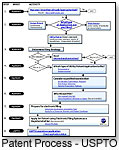 Ideally, at the end of the 12 months, the toy maker will have a better idea of the likelihood of success of the toy. If the non-provisional patent is not pursued, the toy maker must cease using the “patent pending” mark on any of the toys corresponding to an abandoned provisional patent. Continued use of such a mark when there is no application pending can result in legal action and financial penalty. Ideally, at the end of the 12 months, the toy maker will have a better idea of the likelihood of success of the toy. If the non-provisional patent is not pursued, the toy maker must cease using the “patent pending” mark on any of the toys corresponding to an abandoned provisional patent. Continued use of such a mark when there is no application pending can result in legal action and financial penalty. It is also important to note that during its pendency, no application confers rights of exclusivity. The mark “patent pending” simply informs others that a patent may issue and that they should proceed with caution. Even though no exclusivity rights have accrued at the application phase, between a potential toy licensor L having no patent pending and between a patent applicant P who does, P will still be able to offer greater financial reward to a toy manufacturer due to the potential for exclusivity L cannot confer. After a “patentability” examination process at the USPTO, a non-provisional patent will be allowed and issued as a patent that does confer exclusivity rights. The above example of the Ripstik and the Wave shows the value of patent exclusivity among direct competitors. However, banks also recognize that patents have value. PATENT FOR EXPANSION Toy companies in need of capital for operation and/or expansion can collateralize their portfolios to secure financing. In late 1998, Toy Biz used all of its assets, including its portfolio of design patents and utility patents for toys and electronic games, to secure a $200 million bridge loan and $50 million line of credit with UBS. The toy company used this financing to purchase Marvel, including the rights to create toys based on Marvel superheroes. Toy Biz (renamed Marvel Enterprises), expanded its holdings significantly through this deal. The USPTO recorded a release of the patent security interest in 2002. Whether a toy maker seeks a stream of licensing revenue, seeks the marketing or financial resources of a well-known manufacturer to sell its products, or seeks to establish or expand a new brand, patents can help. The patenting process need not be elaborate or expensive. However, in all cases, patent applications must be carefully and thoughtfully executed at the outset.  Writer's Bio: Susan Perng Pan is partner in the Washington, D.C., office of the global intellectual property firm, Sughrue Mion PLLC. She litigates multi-party complex patent disputes before several U.S. federal district courts, the U.S. International Trade Commission, and the U.S. Federal Trade Commission. Her practice also includes preparing and prosecuting patent applications, appeals and interferences before the U.S. Patent and Trademark Office. She may be contacted at span (at) sughrue.com. Read more articles by this author Writer's Bio: Susan Perng Pan is partner in the Washington, D.C., office of the global intellectual property firm, Sughrue Mion PLLC. She litigates multi-party complex patent disputes before several U.S. federal district courts, the U.S. International Trade Commission, and the U.S. Federal Trade Commission. Her practice also includes preparing and prosecuting patent applications, appeals and interferences before the U.S. Patent and Trademark Office. She may be contacted at span (at) sughrue.com. Read more articles by this author |
| |||||||||||||||||||||||||||||||||
Disclaimer Privacy Policy Career Opportunities
Use of this site constitutes acceptance of our Terms of Use.
© Copyright 2025 PlayZak®, a division of ToyDirectory.com®, Inc.


